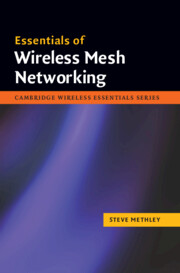Book contents
- Frontmatter
- Contents
- Preface
- Acknowledgements
- 1 Mesh overview and terminology
- 2 Attractive mesh attributes and applications
- 3 Fundamentals of mesh technology
- 4 Mesh capacity, scalability and efficiency – hypothesis testing
- 5 Mesh susceptibility
- 6 Mesh services and quality of service
- 7 Summary of potential mesh pitfalls to avoid
- 8 Appropriate telecommunications applications for mesh
- 9 Successful mesh implementations
- 10 Wireless sensor networks (WSNs) as mesh networks
- Abbreviations
- Selected definitions
- Appendix: Mobility models
- About the author
- Index
- Mesh hints and tips
2 - Attractive mesh attributes and applications
Published online by Cambridge University Press: 01 March 2010
- Frontmatter
- Contents
- Preface
- Acknowledgements
- 1 Mesh overview and terminology
- 2 Attractive mesh attributes and applications
- 3 Fundamentals of mesh technology
- 4 Mesh capacity, scalability and efficiency – hypothesis testing
- 5 Mesh susceptibility
- 6 Mesh services and quality of service
- 7 Summary of potential mesh pitfalls to avoid
- 8 Appropriate telecommunications applications for mesh
- 9 Successful mesh implementations
- 10 Wireless sensor networks (WSNs) as mesh networks
- Abbreviations
- Selected definitions
- Appendix: Mobility models
- About the author
- Index
- Mesh hints and tips
Summary
In the preceding chapter we showed that meshes were good for extending coverage beyond the existing network edge, without requiring additional infrastructure – a sufficient number of user nodes, in the right places, was all that was required. We also implied that this meant that obstacles to propagation such as buildings in the line-of-sight might be less of a problem, given that a mesh could hop around them in a way which cellular systems cannot. We even dropped a small application hint that the structure of a mesh can be quite similar to a grid of downtown city streets. In this chapter we look more closely at linking a number of useful application scenarios with the relevant attributes of a mesh.
We now propose that there are, at heart, only two worthwhile motivations for mesh networks. These are
coverage improvement,
lack of infrastructure.
All successful examples of meshing or multi-hopping known to us embody one or both of these core mesh attributes.
To support this conclusion, we now spend some time considering application scenarios. Overall, from a technology standpoint, we found it hard to envisage any new services which only a mesh could support, although vehicle ad hoc networks and wireless sensor networks are probably the closest – but even here a mesh is the best rather than the only solution. Rather it seems more likely that a mesh would contribute by delivering services in a new way. Six suitable application areas are identified below where mesh adoption is thought to be most likely. In hindsight, it is easy to see that all six applications are based on a mesh network's valuable attributes of coverage and/or reduced reliance on infrastructure.
- Type
- Chapter
- Information
- Essentials of Wireless Mesh Networking , pp. 15 - 26Publisher: Cambridge University PressPrint publication year: 2009



